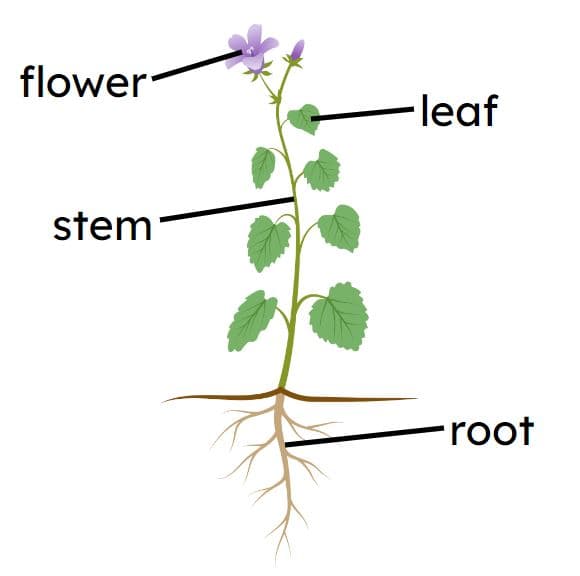Starter quiz
 Which part of a plant absorbs water from the surroundings?
Which part of a plant absorbs water from the surroundings?- A
- B
- C
- D ✓
-
- Producers use water in a process called ______ to make glucose, which requires energy from light.
- 'photosynthesis' ✓
- Which gas is a reactant in photosynthesis?
- 'carbon dioxide' ✓
- Match each structure to its correct function.
- root hair cell⇔absorb water and minerals from the soil ✓
- xylem⇔transport water and minerals from the root to the rest of the plant ✓
- stomata⇔pores that open to allow gasses to move in and out of leaves ✓
- How do plants absorb nitrate ions from the soil?
- osmosis
- diffusion
- active transport ✓
- gas exchange
-
- Plants roots absorb magnesium ions from the soil. Why do plants need magnesium?
- to make proteins
- to make carbohydrates
- to make lipids
- to make DNA
- to make chlorophyll ✓
-
Exit quiz
 What is the name of the part of the plant that has hair cells to absorb water?
What is the name of the part of the plant that has hair cells to absorb water?- 'root' ✓
- Match each structure to its correct role.
- root hair cell⇔provides a large surface area for the absorption of water and minerals ✓
- xylem⇔a tissue in plants that transports water and mineral ions ✓
- stomata⇔open and close to enable gas exchange and control water loss ✓
 Stomata are surrounded by two ______ cells that open and close the pore.
Stomata are surrounded by two ______ cells that open and close the pore.- 'guard' ✓
- Which of the descriptions does not apply to xylem?
- Cells are joined together to make a continuous tube.
- It is composed of dead cells.
- The cell walls are permeable to water. ✓
- The cell walls are lignified.
- The cells have no cytoplasm.
-
- Match each term to its correct meaning.
- transpiration⇔loss of water from the leaves of plants ✓
- transpiration stream⇔movement of water from the roots to the leaves of plants ✓
- mineral ions⇔substances needed to make proteins and chlorophyll ✓
- flaccid⇔plant cells lacking enough water to make them firm ✓
- turgid⇔plant cells full of water making them swell and become firm ✓
 In which direction are water and dissolved mineral ions moved through the xylem?
In which direction are water and dissolved mineral ions moved through the xylem?- in both directions
- only from the roots, up the stem to the leaves ✓
- only from the leaves, down the stem to the roots
-
Worksheet
Presentation
Video
Lesson Details
Key learning points
- Water and mineral ions are transported from the roots, up the stem, to the leaves, in vessels made of xylem.
- Xylem is made of dead, empty cells with no cytoplasm, that form a tube with a tough wall made of lignin.
- Water is continually lost from the surface of a plant when water molecules diffuse into the air through open stomata.
- Water is pulled up through xylem tubes to replace the water lost through open stomata; this process is transpiration.
- The water that is pulled through xylem tubes has mineral ions dissolved in it, including nitrate ions.
Common misconception
If students fail to understand that water only enters the plant at the roots, and not through the leaves, then the process of transpiration will be very muddled and confused.
The lesson reinforces the pathway that water takes through the plant, clearly stating that water enters at the roots, and showing several times how it moves up through xylem.
Keywords
Mineral ions - substances that are essential for healthy plant growth, including nitrates and magnesium
Xylem - specialised vessels in plants that transport water and mineral ions
Stomata - pores in the leaf through which water, oxygen and carbon dioxide can diffuse
Transpiration - the loss of water from a plant’s leaves
Transpiration stream - the continuous movement of water from the roots to the leaves through the xylem